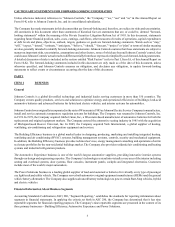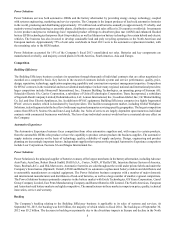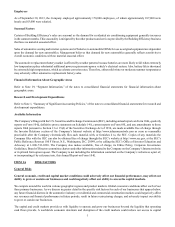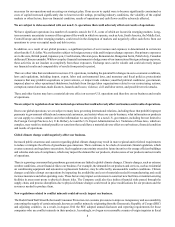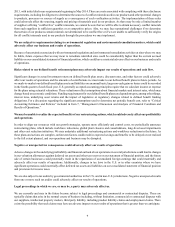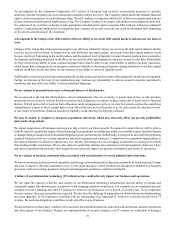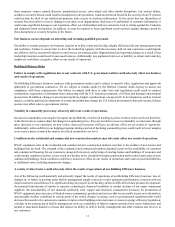Johnson Controls 2013 Annual Report Download - page 13
Download and view the complete annual report
Please find page 13 of the 2013 Johnson Controls annual report below. You can navigate through the pages in the report by either clicking on the pages listed below, or by using the keyword search tool below to find specific information within the annual report.
13
The cyclicality of original equipment automobile production rates may adversely affect the results of operations in our
Automotive Experience business.
Our Automotive Experience business is directly related to automotive production by our customers. Automotive production and
sales are highly cyclical and depend on general economic conditions and other factors, including consumer spending and
preferences. An economic decline that results in a reduction in automotive production by our Automotive Experience customers
could have a material adverse impact on our results of operations.
A variety of other factors could adversely affect the results of operations of our Automotive Experience business.
Any of the following could materially and adversely impact the results of operations of our Automotive Experience business: the
loss of, or changes in, automobile supply contracts, sourcing strategies or customer claims with our major customers or suppliers;
start-up expenses associated with new vehicle programs or delays or cancellations of such programs; underutilization of our
manufacturing facilities, which are generally located near, and devoted to, a particular customer’s facility; inability to recover
engineering and tooling costs; market and financial consequences of any recalls that may be required on products that we have
supplied; delays or difficulties in new product development and integration; quantity and complexity of new program launches,
which are subject to our customers’ timing, performance, design and quality standards; interruption of supply of certain single-
source components; the potential introduction of similar or superior technologies; changing nature of our joint ventures and
relationships with our strategic business partners; global overcapacity and vehicle platform proliferation; divestiture of the
businesses held for sale could result in a gain or loss on sale to the extent the ultimate selling price differs from the current carrying
value of the net assets; and potential complications and complexities encountered during the intended divestiture of our Electronics
business.
Power Solutions Risks
We face competition and pricing pressure from other companies in the Power Solutions business.
Our Power Solutions business competes with a number of major domestic and international manufacturers and distributors of lead-
acid batteries, as well as a large number of smaller, regional competitors. The North American, European and Asian lead-acid
battery markets are highly competitive. The manufacturers in these markets compete on price, quality, technical innovation, service
and warranty. If we are unable to remain competitive and maintain market share in the regions and markets we serve, our results
of operations may be adversely affected.
Volatility in commodity prices may adversely affect our results of operations.
Lead is a major component of our lead-acid batteries, and the price of lead may be highly volatile. We attempt to manage the
impact of changing lead prices through the recycling of used batteries returned to us by our aftermarket customers, commercial
terms and commodity hedging programs. Our ability to mitigate the impact of lead price changes can be impacted by many factors,
including customer negotiations, inventory level fluctuations and sales volume/mix changes, any of which could have an adverse
effect on our results of operations.
Additionally, the prices of other commodities, primarily fuel, acid, resin and tin, may be volatile. If other commodity prices rise,
and if we are not able to recover these cost increases through price increases to our customers, such increases will have an adverse
effect on our results of operations. Moreover, the implementation of any price increases to our customers could negatively impact
demand for our products.
Decreased demand from our customers in the automotive industry may adversely affect our results of operations.
Our financial performance in the Power Solutions business depends, in part, on conditions in the automotive industry. Sales to
OEMs accounted for approximately 25% of the total sales of the Power Solutions business in fiscal 2013. Declines in the North
American, European and Asian automotive production levels could reduce our sales and adversely affect our results of operations.
In addition, if any OEMs reach a point where they cannot fund their operations, we may incur write-offs of accounts receivable,
incur impairment charges or require additional restructuring actions beyond our current restructuring plans.
A variety of other factors could adversely affect the results of operations of our Power Solutions business.
Any of the following could materially and adversely impact the results of operations of our Power Solutions business: loss of, or
changes in, automobile battery supply contracts with our large original equipment and aftermarket customers; the increasing quality
and useful life of batteries or use of alternative battery technologies, both of which may adversely impact the lead-acid battery


